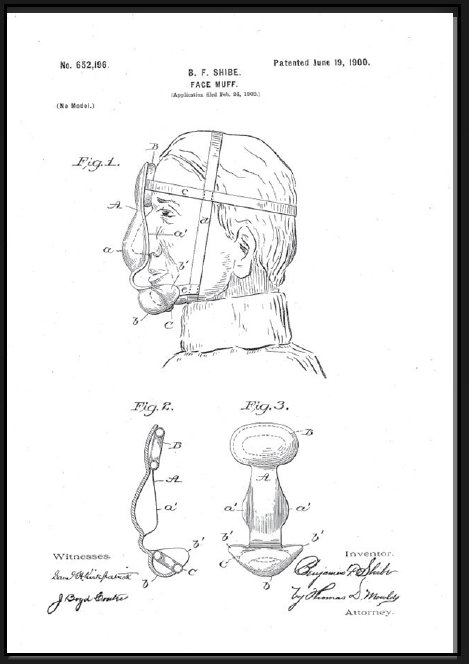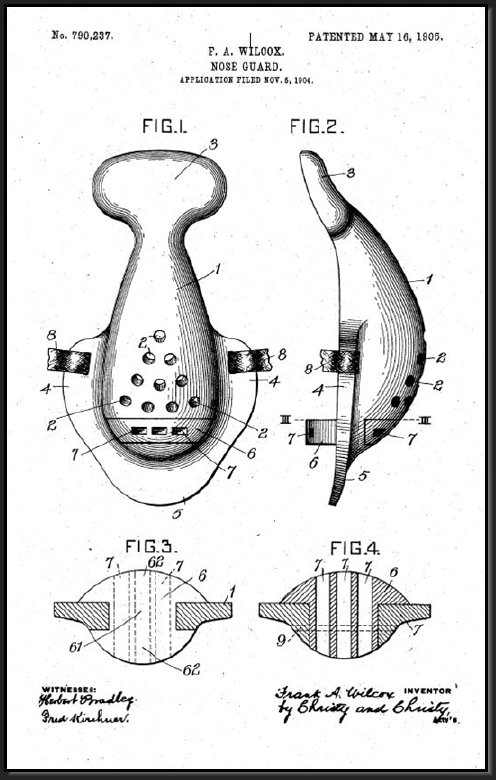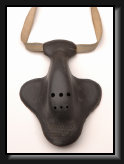


Perhaps due to its complicated double strap configuration, Shibe’s Face Mask disappeared from catalogs shortly thereafter and to this author’s knowledge there are no known surviving examples or period photos of players wearing the Face Muff. The apparent lack of popularity and short production run of Shibe’s Face Mask would make any surviving example the rarest of all football nose masks.
Shibe’s Face Mask, Tryon Catalog 1902
Image Courtesy of Antiquesportsshop.com
Image Courtesy of Antiquesportsshop.com
Shibe's 'Face Muff'
Benjamin Franklin Shibe is best known as the owner and president of the Philadelphia Athletics from 1901 until 1922. However, prior to becoming a team owner, Shibe was a partner in A.J. Reach & Company, where he invented the "Face Muff." Issued Patent No. 652,156 on June 19, 1900, the Face Muff is perhaps the most bizarre style of the most bizarre piece of early football equipment. The purpose of Shibe’s improvement to the nose mask was to eliminate the mouth guard, which restricted breathing from the mouth and the ability to call plays. According to Shibe in his patent application:
My invention relates to a combined nose and mouth guard for foot-ball players; and the object of my improvement is to construct a comparatively-small and comfortable guard that will be a complete protection to the nose and mouth and at the same time allow the player to breath easily and naturally through the nose or the mouth, or both, as may be most desirable. To accomplish the desired result, I construct the guard of stiff leather, paper, or any suitable material and of such a size and shape that it will fit over the nose and mouth and extend from the forehead to the chin, touching only upon these parts of the face. Where the guard touches the fore-head and chin it is provided with suitable cushions that will reduce the force of any blow and also aid in keeping the guard in place upon the face of the player.
The rigid Face Muff was secured to the face by two elastic straps that formed a harness around the head. Shibe also proposed to incorporate shock-absorbing pneumatic ring cushions at the forehead and inside the chin cup. Edward K Tryon Jr. & Co., a Philadelphia sporting goods retailer, included the Shibe’s Face Mask in their 1902 catalog. The mask illustration (above) shows the Reach logo and the description reads:
Shibe’s Mask is a thorough face protector; it prevents injury to the nose, mouth, teeth, and chin, and at the same time does not interfere with the breathing. Its chief advantage over the old style mask is that signals can be given without taking it off. Adjustable to any style head harness. Price, ………..$2.25

Patent Illustration, Patent 652,196, “Face Muff” Benjamin F. Shibe, submitted February 24, 1900
A new nose guard design, the Penna Guard, first appeared in sporting goods catalogs around the turn-of-the-century. The Penna Guard featured a strap which connected at either side of the nose and looped around the upper rear of the head. The guard possessed two square air holes through the mouthpiece and three or more triangular air holes in the nose portion, so that the guard “hangs by neck band when not in use.” With a relatively short production run and apparent lack of popularity, only a handful of Penna Guards exist today.
The Penna Guard
On May 16, 1905, Frank Albert Wilcox of Jeannette, Pennsylvania was issued U.S. Patent No. 790,237 for a “certain new and useful Improvement in Nose-Guards.” Wilcox’s invention sought to increase the utility of the nose guard by incorporating a mouthpiece that could be replaced when worn out. According to Wilcox’s patent application:
The Wilcox Guard
Penna Nose Mask, Circa 1908
My invention concerns the construction of nose-guards such as are worn by foot-ball players; and the object of my improvement is to render these nose-guards more durable. A player using my improved nose-guard having on hand additional mouthpieces may readily remove a damaged mouthpiece and replace it with a new one, whereas lacking my improvement an entirely new guard would be required.
1908 Sears Ad, Rubber Nose Mask
The patent illustration envisioned Wilcox's mouthpiece modification to a standard Penna Guard. However, by the time the invention entered into mass production, it was manifested into an entirely new model of the Penna Guard. The No. 1P included a "Chin Piece" extension that "comes down well over the Chin thus affording perfect protection of the Chin." A youth size, the No. 1P.B, was also offered for sale.
By 1906, Wilcox's removable mouthpiece was incorporated into a new model Morrill Nose Mask, the No. O, which came in two sizes, the No. 0 (full size) and the No. 0-B (youth’s size). Both the Penna and Morrill guards were embossed “Patented May 16-05” on the front, beneath the mouthpiece.
The removeable mouthpiece feature of the Wilcox guard was a hit with players and it soon replaced the No. 1 as the most popular mask on the market. In fact, the No. 0 and 0B continued to appear in football catalogs until the early 1940's, when they were replaced by rubber facemasks designed to be attached to helmets.
By 1906, Wilcox's removable mouthpiece was incorporated into a new model Morrill Nose Mask, the No. O, which came in two sizes, the No. 0 (full size) and the No. 0-B (youth’s size). Both the Penna and Morrill guards were embossed “Patented May 16-05” on the front, beneath the mouthpiece.
The removeable mouthpiece feature of the Wilcox guard was a hit with players and it soon replaced the No. 1 as the most popular mask on the market. In fact, the No. 0 and 0B continued to appear in football catalogs until the early 1940's, when they were replaced by rubber facemasks designed to be attached to helmets.

Patent Illustration, Patent 790,237, “Nose Guard” P.A. Wilcox
submitted November 5, 1904
submitted November 5, 1904
Photo of players wearing Penna Guards, 1905
The History of the Football Nose Mask
Football's Most Unusual Protective Device








Morrill's Improved Nose Mask
Player Photo, 1908
Morrill's Improved Nose Mask No. 1, circa 1901-1923
Chris Hornung
March 10, 2015
Updated July 2, 2017
Page 3
March 10, 2015
Updated July 2, 2017
Page 3
Circa 1906 Penna Guard, Legendary Auctions, August 2008
Penna Guard Advertisement, 1909 Rawlings catalog
